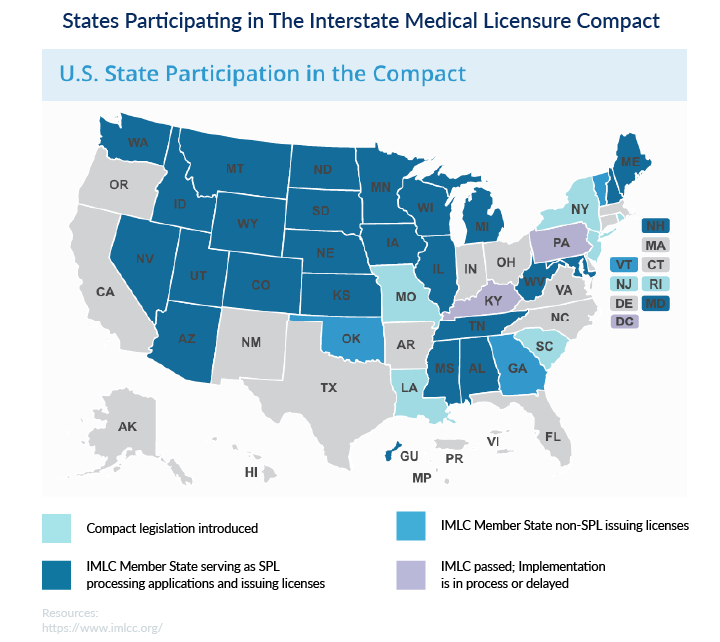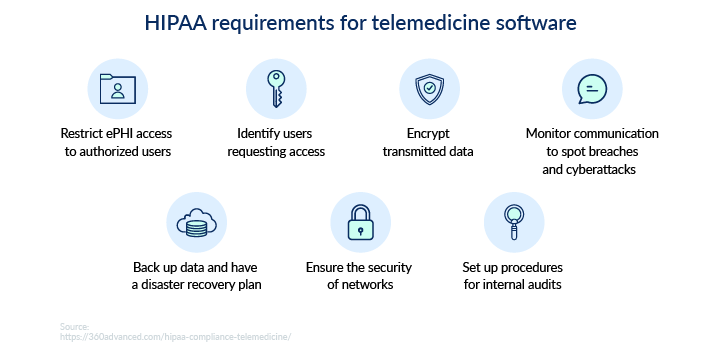Telemedicine presents valuable benefits to your medical practice. It helps you improve access to care, foster patient engagement, and reduce costs. However, it’s important to consider the legal pitfalls you may encounter when implementing a telemedicine program.
If you decide to add telemedicine to your practice, make sure you act lawfully and maintain regulatory compliance. In this article, we address common legal challenges in telemedicine and suggest tips to reduce liability risks.
Practicing telemedicine in multiple states
The US medical licensing system remains quite a barrier to the ubiquitous adoption of telemedicine. According to the Federation of State Medical Boards (FSMB), 49 states require physicians to be licensed in the state where a patient is located. Moreover, each state has its own policies on particular aspects of telemedicine: patient informed consent, doctor–patient relationships prior to telemedicine consultations, online medication prescribing, etc. If you want to provide virtual care in multiple states, you should consider even the smallest variations in rules.
In 2020, telemedicine policies were loosened to help clinicians fight the COVID-19 outbreak. Although these waivers are temporary, the modifications may stick around and positively influence the telemedicine legislation landscape.
Tip: Mitigate risks of license-related legal issues
With the development of licensure compacts, it has become much easier to secure medical licenses in multiple states. The Medical Licensure Compact Commission reports that 7,400 physicians were able to secure over 9,400 medical licenses through March 31, 2020. If you need to get licensed in multiple states participating in the compact, you can do so by completing one application form. To reduce the risk of legal issues related to licensing, you should take the following steps:
- Determine in what states you’ll provide telemedicine services.
- Check if all members of your care team have the proper licenses.
- Use licensure compacts to secure missing licenses.
- Eliminate the chance of accidentally providing care to a patient in an area in which your team members are not licensed.

Getting reimbursed for telemedicine services
If you’d like to bill federal and private insurers for your telemedicine services, you should do your best to follow telemedicine reimbursement policies. The Centers for Medicare and Medicaid regularly review their state-specific policies. Look through the lists of medical specialists that can use telemedicine, billable types of services and CPT codes, payment parity laws, etc.
If you decide to work with payers, you should know how to deal with unpaid claims and insurance audits. Some of your claims may be denied and require you to send an appeal for reconsideration, and paid claims may be reconsidered later by the insurer via an audit request. To resolve such issues successfully, you should ensure your telemedicine software lets you document virtual visits and properly store each patient’s records.
In view of the complexity of reimbursement requirements, billing all your telemedicine services directly to patients can be a good alternative. Chances are your patients will value the convenience of telemedicine highly enough to pay for it out of pocket, enabling you to forgo insurance billing completely. In this case, you can benefit from the payment features of your telemedicine software to the maximum and completely automate your payment management.
Tip: Align your workflow with payers’ reimbursement rules
To protect yourself from telemedicine legal issues related to reimbursement, it’s best to call insurers for final instructions on billing and documentation requirements for remote care services. To minimize misalignment with payers’ telemedicine reimbursement policies and avoid revenue losses, follow the steps below:
- Study telemedicine reimbursement laws in the states your program covers.
- List the payers you’ll potentially deal with (Medicaid, Medicare, and private insurers).
- Clarify the CPT codes and types of services each payer considers billable.
- Align triage procedures with payers’ rules on qualifying patients for telemedicine.
- Set up proper preauthorization and reimbursement claim procedures.
- Know how to make an appeal if your telemedicine claims are initially denied.
- Learn what data to provide when you get an audit request related to telehealth services.
- Ensure proper documentation of virtual care and proper storage of medical records.
Ensuring HIPAA compliance and patient data privacy
The most costly telemedicine legal issues relate to managing Electronic Protected Health Information (ePHI) and can arise from the misuse, loss, destruction, or breach of patients’ stored data. A breach of HIPAA rules can cost you your practice; apart from the penalty itself, you’ll face expenses connected with data breach investigations, providing credit monitoring services for patients, and loss of reputation. To protect your practice from possible financial damage, you and your telemedicine technology partners should follow the HIPAA Privacy and Security Rules.
To encourage healthcare providers to embrace telemedicine to fight the COVID-19 pandemic, the Office for Civil Rights decided not to impose penalties for HIPAA-related issues with telemedicine. They have temporarily allowed practitioners to use any available communication channels to remotely interact with their patients. However, HIPAA rules would generally require you to use secure communication channels. To practice telemedicine after COVID-19, you won’t be able to rely on popular video chatting applications such as Skype or FaceTime but will need to use specialized telemedicine software.
Tip: Choose HIPAA-compliant telemedicine software
We suggest you check your telemedicine software solution against the HIPAA requirements listed below, sign a Business Associate Agreement, and conduct an independent HIPAA risk assessment before launching your telemedicine program.

Getting telemedicine malpractice insurance coverage
Any time you introduce a new layer of service, you should review your professional liability insurance to verify that this service is covered by your insurance provider. Telemedicine is not an exception. On the one hand, by using telemedicine, you reduce your risk of medical malpractice because telemedicine helps you switch from off-hours or undocumented phone calls to billable telemedicine visits. On the other hand, it increases your privacy exposure due to engaging a new software medium and operating over the internet.
Before you roll out a telemedicine program, you should contact your malpractice insurance provider and confirm your coverage. In many cases, your current insurance policy may not automatically cover virtual care. The inclusion of telemedicine in your liability insurance may involve some additional cost and require adding a rider to your current policy. Your insurer will probably do this at a low cost, however, as insurers tend to consider telemedicine low liability, as it doesn’t deal with any complex or high-risk procedures.
The Center for Connected Health Policy recommends providers look for cyber liability insurance that covers electronic security issues like data breaches. This type of insurance can help you cover legal fees, damaged networks, software, or hardware, and other associated losses.
Tip: Dive into the details to ensure adequate insurance coverage
It would be good to find a knowledgeable insurance broker who has experience with the ins and outs of telemedicine malpractice coverage. You should ask questions and dive into details to negotiate your coverage limits and ensure they’re in line with the scope of your telemedicine program. Our checklist will help you evaluate your telemedicine malpractice insurance options and choose the right one.

Want to practice telemedicine safely?
The need to comply with numerous laws and policies related to telemedicine can cause frustration. Yet the right software solution can make following all the rules surprisingly easy on your practice. Software vendors like ExpertBox are aware of the common legal issues related to telemedicine and ways to prevent them.
If you're thinking about adopting telemedicine in your own practice, take a look at this comprehensive guide on how to successfully get started with telemedicine. You’ll learn best practices for implementing telemedicine services, tips to avoid potential issues, and much more.

